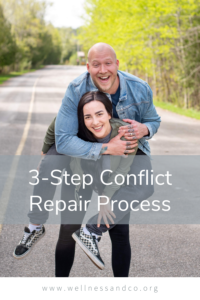Follow
Wellness & Co.
Hi, I'm Dr. K, Wellness & Co. is a growing therapy/coaching practice and educational hub for prospective clients based in Maryland and virtual clients all over the world!
Hi, I'm Dr. K
free guide
e -books
e -course
3-Step Conflict Repair Process
November 23, 2020
by Amanda & Dylan, Relationship Coaches, Enneagram Teachers
Conflict is one of the top reasons that couples walk through our virtual door. It makes sense, conflict is inevitable in relationship. AND conflict can be used as a catalyst for deeper connection.

It’s Not About THAT
Have you noticed that the fights in your relationship are rarely, if ever, about what is actually happening? Like the toilet paper not being filled up, a light not being turned off, the dishes not being put away, the mail being opened wrong. The fights themselves are not about what’s happening on the surface, rather they are about what’s happening underneath. The deeper issues that are calling for your attention and care.
When unaware and acting from Type Structure (the lower levels of our Enneagram Type), we become trapped in vicious cycles that prevent us from having healthy conversations and healing conflict.
As we begin our work with couples, we teach them three key steps that become their new intentional cycle they use both inside and outside of the sessions. These are the *continuous* steps that couples take as they walk alongside each other in their lifelong journey of loving and learning.
Step 1: Awareness
Awareness means being able to see clearly what is happening (those deeper issues we were talking about). But awareness alone doesn’t create change, it’s what we do with that awareness that really matters.
As couples learn about their Type and their partners Type, and they do it together, it allows them to identify the automatic patterns, notice their Type Structures in action, and observe and pause to create more space for conscious choice.
Having the opportunity to choose may well be the most empowering thing we can do, it’s what creates real change, and that is what we need to *lovingly* break the conflict cycle.
When we can see what’s happening, it allows us to expand our view beyond the narrow perceptual lens through which we have been experiencing life and open our eyes to what has been really going on. Because we are not just angry about the toilet paper, we may be angry about not feeling heard, not feeling important, not feeling validated, not feeling supported.
This willingness to see is the pathway to understanding.
Step 2: Understanding
As we build understanding around our Type, we have greater access to the deeper qualities of who we really are.
When you learn about both of your Types underlying motivations that drive your behavior, and recognize that the behaviors are learned and therefore can be unlearned, you can then explore new ways of being to create more space for conscious connection.
Having the “why” behind your thinking, feeling, or acting produces instant insight, and that insight isn’t to blame or shame, but rather to increase consciousness and grow in your Type. Knowing the growth points of our Type means that we have greater resources to use and more love to give.
Understanding your Type helps you identify what’s happening underneath the reactions – it allows you to see the behaviors and know why they are there, what their purpose is, and how to connect when it feels like you want to push people away.
This willingness to know is the pathway to compassion.
Step 3: Compassion
Do you know what compassion means?
‘Co’ means “with”, and the original definition of the word ‘passion’ means “suffering”.
So, compassion literally means to be with suffering.
And in relationship that means to hold a place of grace for each other to show up vulnerably, to release judgment when there is reactivity, and choose to connect to create more space for conscious curiosity.
Being curious is an eagerness towards learning something.
THAT’S what relationship is – continuous learning.
Learning about yourself and each other.
Learning what you both need and why you need it.
Learning why each of you reacts and how to respond instead.
To be curious with your partner in pain, in reactivity, in resistance, is what breaks down the walls we have put up to try and keep ourselves safe. It’s what makes us feel loved, seen, and heard.
It’s what resolves the conflict – Every. Single. Time.
This willingness to learn is the pathway to togetherness.
To Put it Simply
It can be extremely helpful to process conflict after it has happened, especially when you are learning how to repair it in a healthy way.
To practice processing and repairing conflict, try this:
- Become aware of how your Type Structure was showing up
- Seek to understand each other’s underlying thoughts, feelings, and emotions that were occurring during the conflict
- Get curiously compassionate about how you can support, affirm, and love each other in those moments
Big love,
Amanda & Dylan
Up Next: Working with resistance in your relationship!
Dylan is passionate about guiding teens, individuals and couples along the journey of looking within so they can find safety and courage in themselves and each other. He uses the enneagram (a very practical and tangible tool) to bring a deeper understanding to what it means to have self-love, and how to be fully present to your human experiences and relationships.
Leave a Reply Cancel reply
CONTACT
Start Here
BLOG
OUR TEAM
SHOP
ABOUT
©2025 Wellness & Co. | All Rights Reserved | Design by EverMint Design Studio
BACK TO TOP
connect with us on instagram
